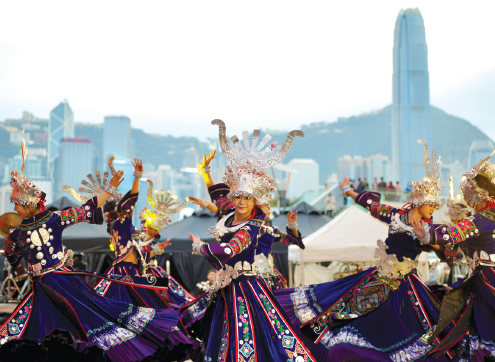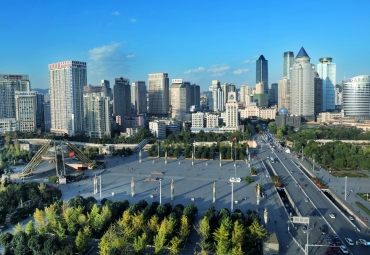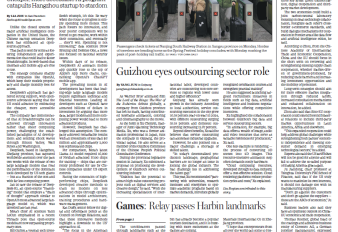Guizhou heritage to liven up festival

Ethnic-minority dancers perform during a media preview for the Chinese New Year Lantern Carnival at the Hong Kong Cultural Centre on Tuesday. The show runs from 7:30 pm to 9:30 pm on Feb 12. Visitors can also enjoy themed lantern displays, lantern riddles, lion dances, and a photo exhibition. ADAM LAM/CHINA DAILY
Intangible cultural heritage and photo collections presenting Guizhou province's natural and cultural charm joined Hong Kong's Lantern Carnival, adding vibes to the city around the Lantern Festival on Feb 12.
The Lantern Carnival, as part of the city's Chinese New Year celebrations, began on Friday at the Hong Kong Cultural Centre in Tsim Sha Tsui, and ran through Feb 12.
The carnival includes the display of a 6-meter-high ornate palace lantern, with a host of small lion-shaped lanterns. All were made by local paper-crafting master Kenneth Mo Cheuk-kei.
An intangible cultural heritage market with 10 stalls took place on Feb 12 in the open-air square of the Hong Kong Cultural Centre, displaying Guizhou's intangible cultural heritage crafts and products such as silver jewelry and batik, a wax-printing technique. The pop-up market is part of the Southwest China province's effort to promote local heritage preservation and tourism.
Cao Mei, who was working at a stall to introduce batik, said that the technique comes from the ethnic minorities of Guizhou and has a history of over 1,000 years. She said that the wax-printing process is very complex, requiring wax to be applied to the cloth before coloring it with natural dyes, such as landian, or indigo.
The entire process, from drawing to dyeing, was completely eco-friendly and done by women from Guizhou villages, reflecting the simple concept of harmonious coexistence between humans and nature, Cao said.
Cao also brought zhuoqi, or tablecloths, teacups and books introducing the patterns of batik to further promote the heritage to Hong Kong visitors.
Hu Rong, a promoter of Guizhou silver jewelry at the market, said that the silver jewelry on display is of high quality, all designed by masters and made by inheritors of the intangible cultural heritage. "Each piece has unique designs," Hu said.
Hu highlighted a very distinctive set of 12 zodiac silver jewelry pieces, including one representing the Year of the Snake. The jewelry was made using the technique of biansi, which involves drawing silver strips into threads thinner than a hair, and then weaving them into patterns by hand.
Next to the market, a Guizhou-themed photo exhibition was also being held simultaneously.
The exhibition displayed about 80 selected photographs and works, arranged according to the themes of natural scenery, development achievements, unique culture and shuichenghua - a unique painting genre originating from the province's city of Liupanshui.
The content of the photos included the natural scenery of Guizhou's cities, karst landscapes and rivers, as well as various activities in Guizhou such as rafting, rock climbing, and paragliding, aiming to entice Hong Kong residents to experience Guizhou in various ways.
On Wednesday night, a lantern-themed Gala Night took place at the square. Actors from various ethnic groups in Guizhou, including the Miao, Bouyei, and Dong, presented a variety of songs, dances, and acrobatic performances.
Hong Kong resident Alex Wong said that the items displayed at the market are exquisite and special, and are hard to buy in Hong Kong. Wong especially liked the silver jewelry and said that he plans to travel to Guizhou in the future to see the different parts of the country firsthand.
After viewing the photo exhibition, Hong Kong resident Karen Lai said that she realizes that Guizhou now is very developed as she noticed the province's convenient transportation system from the photos - an outstanding achievement for the mountainous region.
She also said that Guizhou has many ethnic minorities with special characteristics.
京ICP备13028878号-8







 Overview
Overview
 Guiyang
Guiyang
 Guian New Area
Guian New Area
 Liupanshui
Liupanshui
 Anshun
Anshun
 Qianxinan
Qianxinan
 Qiandongnan
Qiandongnan
 Qiannan
Qiannan
 Zunyi
Zunyi
 Tongren
Tongren
 Bijie
Bijie
 2025 Guizhou Two Sessions
2025 Guizhou Two Sessions
 2025 Share your views on economy, trade in China
2025 Share your views on economy, trade in China
 Grand Song of Dong shines in HK
Grand Song of Dong shines in HK


